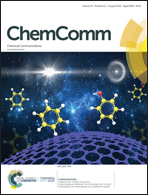Why does a para-amino group make the green fluorescent protein chromophore non-fluorescent: coherent intramolecular charge transfer reduces the Z/E-photoisomerization barrier†
Abstract
A para-N-phenyl-amino group significantly increases the fluorescence quantum yield of N-phenyl-4-aminostilbene by the “amino conjugation effect”, but, in contrast, a para-amino group in the para-amino analogue (p-ABDI) of the green fluorescent protein (GFP) chromophore makes p-ABDI non-fluorescent because the coherent photo-induced intramolecular charge transfer reduces the barrier of the Z/E-photoisomerization.



 Please wait while we load your content...
Please wait while we load your content...